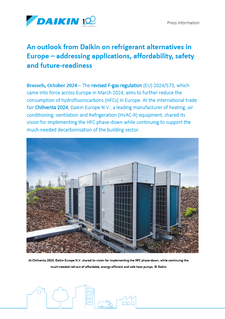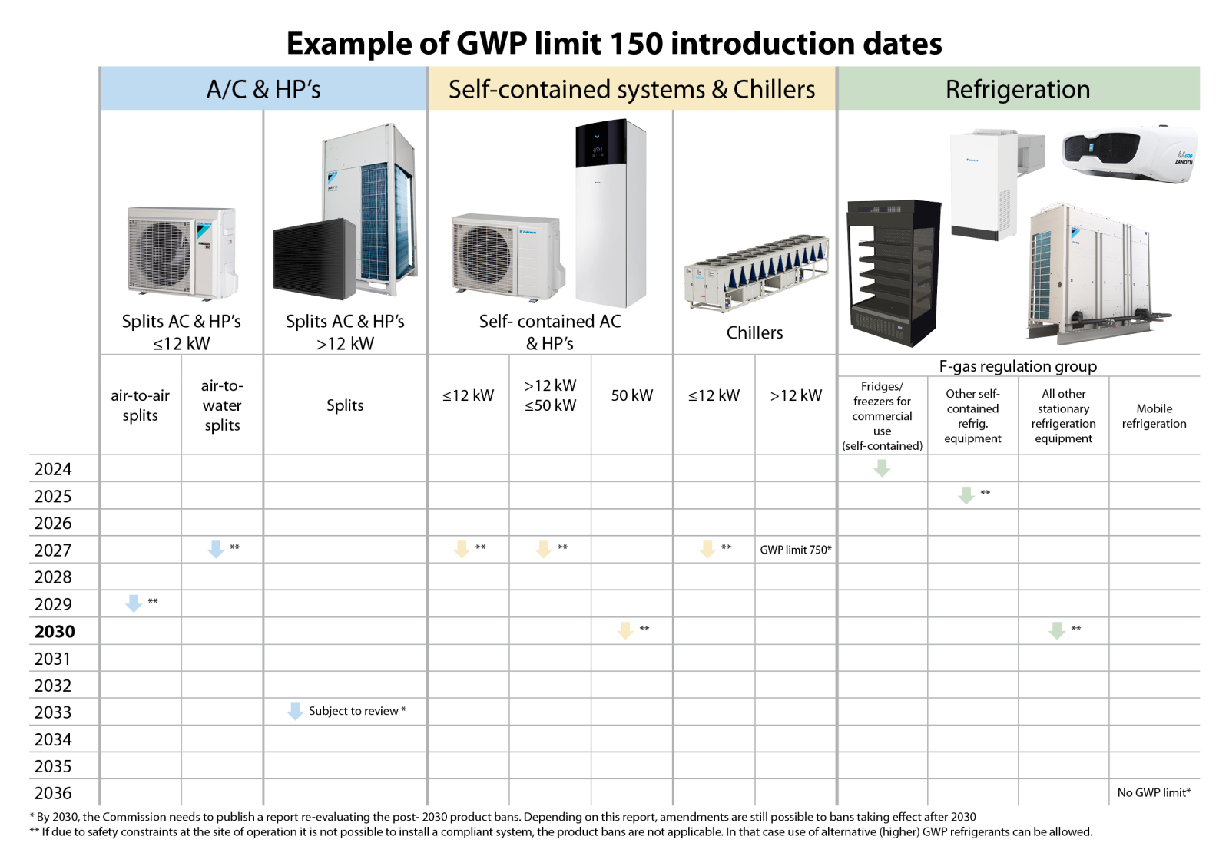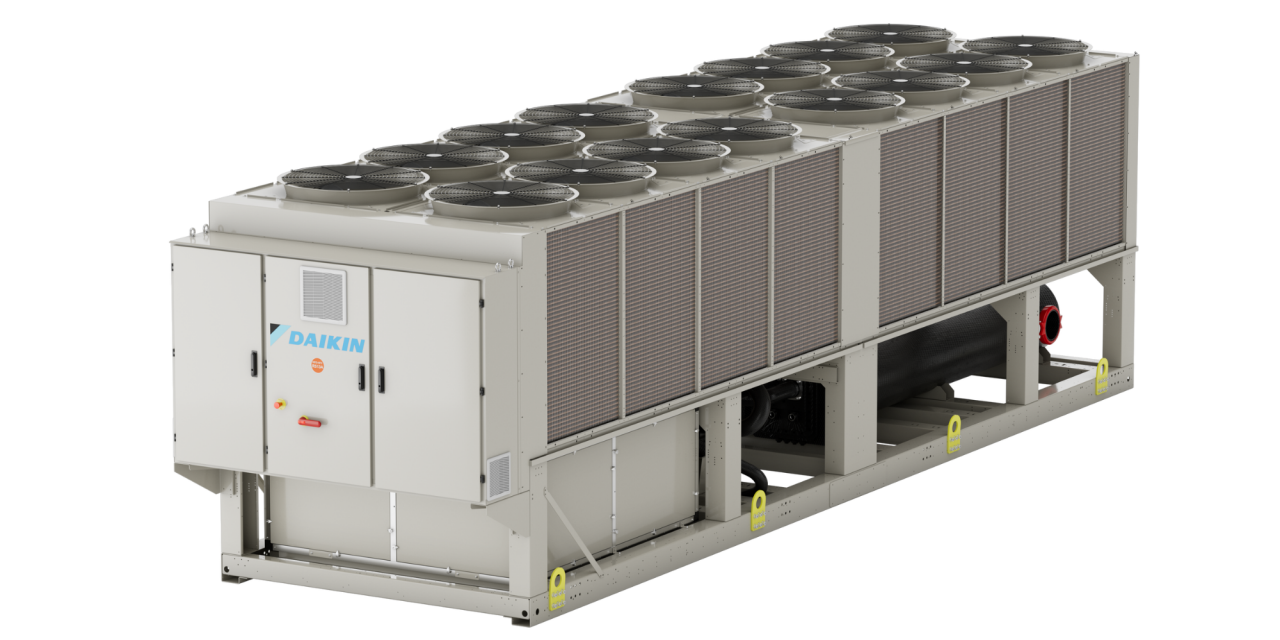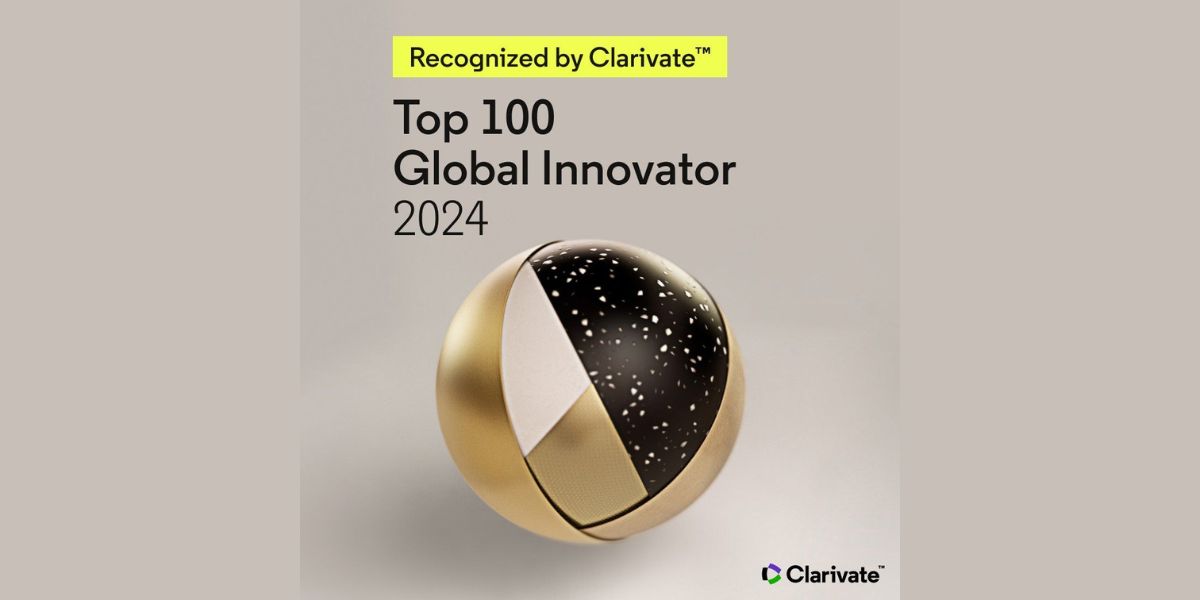
Brussels, October 2024 – The revised F-gas regulation (EU) 2024/573, which came into force across Europe in March 2024, aims to further reduce the consumption of hydrofluorocarbons (HFCs) in Europe. At the international trade fair Chillventa 2024, Daikin Europe N.V., a leading manufacturer of heating, air conditioning, ventilation and Refrigeration (HVAC-R) equipment, shared its vision for implementing the HFC phase-down while continuing to support the much-needed decarbonisation of the building sector.

At Chillventa 2024, Daikin Europe N.V. shared its vision for implementing the HFC phase-down, while continuing the much-needed roll-out of affordable, energy-efficient and safe heat pumps. © Daikin
The revised F-gas regulation
The revised 2024 F-gas regulation accelerates the reduction in the consumption of virgin HFCs through a stricter phase-down plan than the Kigali Amendment, expressed in CO2 equivalents (= total kg of HFCs imported or produced in the EU x the Global Warming Potential (GWP) value). The aim is to promote the use of refrigerants with a lower GWP, reduce refrigerant charge and increase the reuse of recycled or reclaimed refrigerants.

Comparison of the permitted consumption of newly produced HFCs expressed in CO2 equivalents, between the 2014 F-gas regulation EU 517/2014 and updated F-gas regulation EU 2024/573. © Daikin
In addition, GWP limits are introduced for refrigerants used in HVAC-R products. Systems using a refrigerant with a GWP value equal to or above the defined limit may no longer be placed on the market after a certain cut-off date, which varies depending on the type of system. Products already placed on the EU market before the cut-off date may continue to be sold, installed, operated and serviced throughout their entire lifetime. This approach aims to gradually introduce new refrigerants.

Example of cut-off dates for systems with a refrigerant with a GWP limit of 150 defined in the F-gas regulation EU 2024/573. © Daikin
A balanced refrigerant choice per application
Contrary to popular perception, the new F-gas regulation does not mandate an immediate ban on fluorinated refrigerants. In building applications, certain fluorinated refrigerants continue to meet a wide range of safety and performance requirements. Bernard Dehertogh, Deputy General Manager DX at Daikin Europe N.V., emphasises: “To drive the much-needed decarbonisation in the building sector, we need flexibility in refrigerant choices. There is no one-size-fits-all solution, as different applications present different challenges.”
Daikin's strategy is to select the appropriate refrigerant for each application, balancing four key factors: safety, energy efficiency, environmental impact and cost over the entire life cycle of a product.
Possible refrigerant alternatives per application
1) Refrigerant alternatives for air-to-water heat pumps in residential buildings
For residential air-to-water systems, Daikin transitioned to lower GWP refrigerants in 2017, when it began replacing R410A with R32, significantly reducing the refrigerant’s GWP to 675.
Today, R32 is the market standard, and while it remains the most cost-effective solution for air-to-water heat pumps, a shift to alternatives with a GWP below 150 will be required from 2027 onwards (for air-to-water monobloc systems and air-to-water split systems – see illustration above).
A primary alternative to R32 is R290, commonly known as propane, an A3 highly flammable refrigerant with an ultra-low GWP of 0.02. However, due to its high flammability, propane has restrictions in handling, application and installation location. Typically, a minimum distance from windows and doors, pavements or neighbouring properties must be maintained. For these applications, Daikin is launching a hydrosplit heat pump, ensuring that only trained installers handle this equipment through its ‘Stand By Me Certified Programme’.
However, it is clear that in many applications, such as apartment buildings or terraced houses with limited outdoor space, maintaining the minimum distance is not always feasible, and alternative solutions are indispensable.
Therefore, Daikin continues its research into energy-efficient alternative refrigerants, such as R454C, an A2L mildly flammable refrigerant with a GWP of 145.5, which is below the 150 GWP limit. This presents a strong alternative to ensure that all types of residential buildings can access heat pump heating in the near future.
2) Refrigerant alternatives for residential and small commercial air-to-air systems
With its split and multi-split systems, Daikin offers cost-effective air-to-air heat pumps, ideal for replacing electric heating, oil boilers etc. or for use in regions where cooling is also required. As these systems are commonly installed on balconies and the refrigerant circuit extends into the building, they face even greater installation challenges compared to self-contained air-to-water systems when using propane.
To overcome these hurdles, refrigerants such as R454C (GWP 145.5) and CO2 (R744, GWP 1) will become increasingly important for large residential, and small office and retail applications. In the medium term, however, due to the cost-effective properties of R32, we expect it to remain the dominant solution.
3) Looking beyond 2032 for commercial air-to-air heat pumps
For large commercial applications, such as Daikin's VRV systems, the legislation allows for more transition time. In this segment as well, Daikin has led the transition from R410A, the current market standard, to R32. Increasingly, HVAC manufacturers are launching R32 ranges, providing customers with a solution for new installations at least until 2033.
However, it is also time to think ahead. With the phase-down and quota restrictions on the horizon, lower GWP solutions need to be developed. CO2 is the next logical step for VRV systems, as it is an ultra-low GWP, non-flammable type A1 refrigerant. To ensure a smooth transition over the next decade, manufacturers must address energy efficiency and affordability concerns. Additionally, the necessary training programmes should be implemented to prepare the market for handling this higher pressure refrigerant.
Defining the refrigerant portfolio for the road ahead
The path forward will involve many small steps, balancing the different properties of refrigerants with the timeline of the phase-down scheme.
R32 (GWP 675 – A2L) remains the balanced refrigerant for many applications in the years to come, allowing for continued heat pump adoption in a cost-effective way.
R290 propane (GWP 0.02 – A3) provides an energy-efficient, ultra-low GWP solution for specific applications where safety requirements and installation space allow. It comes at a higher cost compared to R32, due to increased safety requirements and refrigerant properties that result in larger units.
R454C (GWP 145.5 – A2L) is a strong alternative with a lower GWP than R32, suitable for applications where propane is not an option. This refrigerant can bring affordable, efficient and safe heat pumps to a broader market.
Finally, R744 CO2 (GWP 1 – A1), an ultra-low GWP refrigerant already used in many refrigeration systems, offers a promising long-term option for medium and large commercial systems. It is a solution that deserves the full attention of all stakeholders in the HVAC market: component and HVAC manufacturers, as well as their engineering and installer partners, with the aim of launching the next generation of direct expansion systems.
Ready for the future
“Daikin is continuing its research and development into alternative refrigerants to accelerate the adoption of heat pumps across all systems and applications. We encourage the entire industry to follow this path. In the future, there may even be solutions that are not yet in the public eye”, says Bernard Dehertogh. “As a manufacturer, we will take responsibility and provide the education and training needed to adopt these new technologies.”
“At the same time, we should not forget that today's heat pump solutions, such as those based on R32, have already significantly reduced CO2 emissions compared to fossil fuel heating. Therefore, we should continue to use these solutions to transition to clean heating based on renewable energy in the medium term”, adds Dehertogh.
All appliances placed on the market before their respective cut-off dates specified in the revised F-gas regulation can be sold, operated, maintained and repaired throughout their entire life cycle.
Did you know?
With the new F-gas regulation (EU 2024/573), some labelling values for refrigerants have been updated. This applies to two refrigerants mentioned in this text. The GWP value for R454C has been reduced from 148.3 (in accordance with F-Gas Regulation EU 517/2014) to 145.5. The GWP value for R290 (propane) was also updated, from 3 (according to assessment report 4) to 0.02.
All GWP values indicated in this text are based on the revised F-gas regulation EU 2024/573.
Copyrights pictures: Daikin Europe
About
100 years Daikin
The story of Daikin has always been shaped by groundbreaking ideas, technological innovations, and dedicated people. It began in 1924 when the young Japanese engineer Akira Yamada founded an enterprise in Osaka to manufacture aircraft radiators with a 15-member team. Today, 100 years later, the Daikin Industries Ltd. group brings future-proof solutions for heating, cooling, ventilation, air purification, and refrigeration to global markets. More than 98,000 employees in 175 countries continue the company's legacy of leading technologies to advance low carbon heating and cooling, while ensuring the highest level of comfort. For its fiscal year 2023 the global Daikin Group reported a record sales result of € 28 billion sales (1 April 2023 – 31 March 2024).
Read more on 100 Years Daikin
Daikin Industries Ltd.
Daikin Industries is a worldwide leader in heat pump, air conditioning, and air filtration technology, employing more than 98,000 people. Founded in Osaka in 1924, it is the only manufacturer in the world that develops and manufactures HVAC-R equipment, compressors and refrigerants in-house. Daikin has been recognized as one of the world’s top 100 most innovative companies by Clarivate (UK) and LexisNexis (USA) for its leadership in technology research and intellectual property patents. For its fiscal year 2023 (April 1, 2023 – March 31, 2024), the Daikin reported a record sales result of €28 billion.
Read more on www.daikin.com
Daikin Europe N.V.
The Daikin Europe Group is a leading provider of heating, cooling, ventilation, air purification and refrigeration (HVAC-R) technology across Europe, Middle East, and Africa. Daikin designs, manufactures, and offers customers a broad portfolio of products, maintenance services, and turnkey solutions for residential, commercial, and industrial applications. The group currently employs over 13,800 people across more than 59 subsidiaries and operates 14 manufacturing sites in Belgium, the Czech Republic, Germany, Italy, Spain, Austria, the United Kingdom, Turkey, the United Arab Emirates, and the Kingdom of Saudi Arabia. Headquartered in Ostend, Belgium, for over 50 years, the Daikin Europe Group is a subsidiary of Daikin Industries Ltd.
Read more on www.daikin.eu
Daikin Airconditioning Central Europe
Daikin Airconditioning Central Europe, founded in 1999 with its headquarters in Vienna, Austria, operates as a subsidiary of Daikin Europe. Its portfolio includes products and total solutions for heating, cooling, ventilation, air purification, and refrigeration in residential, commercial, and industrial settings. With over 700 employees and 3,400 partners, the company manages sales and service activities across 16 countries in Central and Eastern Europe, including Austria, Albania, Bosnia and Herzegovina, Bulgaria, Croatia, the Czech Republic, Hungary, Kosovo, Montenegro, Moldova, North Macedonia, Poland, Romania, Serbia, Slovakia, and Slovenia.
With 'Your Daikin World' at the Vienna headquarters and the 'Daikin Inspiration Park,' the HVAC-R industry and the construction sector have access to two state-of-the-art B2B-experience centers for co-creating tailor-made solutions for hotels, retail, offices, and large commercial applications. Across the CE-region Daikin runs 10 out of 116 B2B-trainings centers across Europe. Consumers and homeowners receive consultations at four B2C-Experience centers in Vienna, Belgrade, Bratislava and Budapest.
Read more on www.daikin-ce.com
Media contact
Daikin Europe N.V.
Sofie Sap – T.: +32 472 580482 Mail: sap.s@daikineurope.com
Daisuke Kakinaga – T.: +32 465 462321 Mail: kakinaga.d@bxl.daikineurope.com
Daikin Central Europe
Doris Passler
Manager Corporate Communications Central Europe
Daikin Airconditioning Central Europe HandelsgmbH
Lemböckgasse 59/1/1, 1230 Vienna, Austria
T: +43 (0) 664 24 56 444
M: passler.d@daikin.at
-
 Press Information An outlook from Daikin on refrigerant alternatives in Europe at Chillventa 2024PDF | 737.78KB
Press Information An outlook from Daikin on refrigerant alternatives in Europe at Chillventa 2024PDF | 737.78KB -
 VRV 5 Installation pictureJPG | 1.75MB
VRV 5 Installation pictureJPG | 1.75MB






